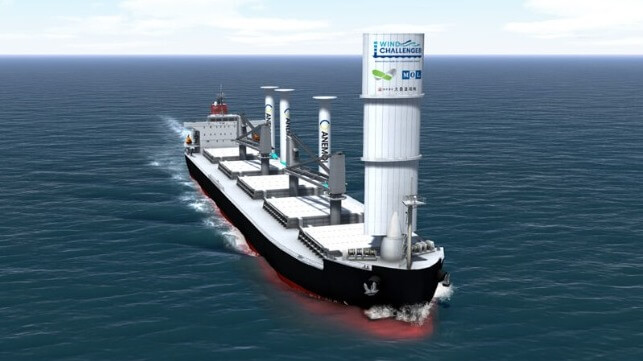MOL Plans Bulker Combining Rotors and a Rigid Sail

A new bulker expected to launch in 2024 will become the first large merchant vessel to incorporate two of the emerging wind propulsion technologies to improve the vessel’s performance and reduce its environmental impact. Using both rotor sails and a rigid sail, the companies viewed it as a pilot project that they believe will be at the leading edge of the new trends in shipping.
Japan’s Mitsui O.S.K. Lines’ subsidiary MOL Drybulk is leading the project working with its longtime partner and customer wood bioenergy company Enviva. MOL Drybulk operates woodchip carriers for Enviva and 14 months ago the two companies announced they were studying technologies to make next-generation bulkers more environmentally friendly.
The companies have now signed a unique partnership that calls for the development of a 62,900 dwt bulker that will combine the new technologies. The vessel will be built by Oshima Shipbuilding which has been working with MOL on the rigid sail known as Wind Challenger. Together the shipping company and shipyard have received certification for the rigid sail.
“The environmentally-friendly bulk carrier is a great example, and we cannot wait to see this truly unique vessel set her sails and catch the wind,” said Kazuhiko Kikuchi, President and Representative Director of MOL Dry Bulk during the signing ceremony. Enviva notes that they have been working to reduce emissions through their operations and this will be a critical step for their supply chain.
Few details were released about the designs for Enviva but the rendering shows a bulker that incorporates the Wind Challenger rigid sail along with three rotor sails interspaced between the hatches. Typically, these bulkers are about 650 feet long.
The rotors will be supplied by Anemoi which has also been working with MOL on bulker designs incorporating its technology. Anemoi installed the world's first rotor sail on a newbuilding Ultramax bulk carrier in 2018. The company promotes the modern adaptation of the technology highlighting that it is lightweight, automated in its operations, and optimized for weather. The rotors range between approximately 60 and 115 feet in height with a diameter ranging between approximately 10 and 15 feet. They can be fixed to the deck, on rails to move to permit easier loading and unloading of cargo, or tilting. MOL is working with Anemoi and Vale to explore the concept of fitting rotors on a 200,000-ton bulker.
The Wind Challenger started in 2009 as an industry-academia joint research project led by the University of Tokyo. MOL took charge of the project in 2018 continuing to work on the technology. The system converts wind energy to propulsive force with a telescopic hard sail that will be fixed near the bow of the ship and stands approximately 170 feet high when fully raised at sea.
Oshima shipyard built a working version of the Wind Challenger and has been testing it at the shipyard for the past few months. The shipyard and MOL Dry Bulk plan to launch the first application of the technology on another bulker due to start operating later this year as part of a coal transport deal reached with Tohoku Electric Power Co. That vessel is a 99,000 dwt vessel that will have a length of approximately 770 feet.
